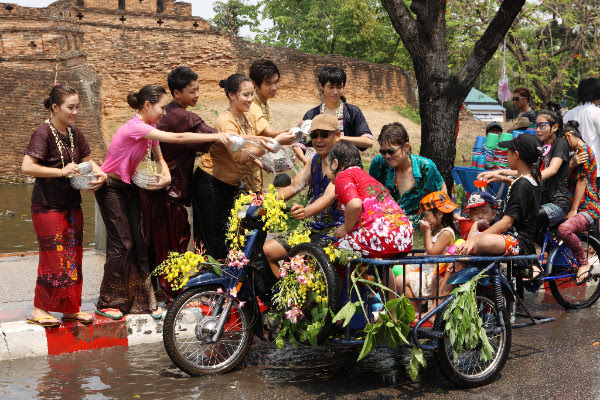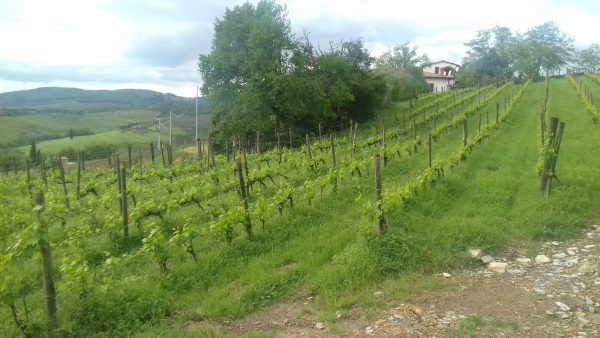
Contributed by Melissa Richter
When it comes to Thailand, wine appreciation is often viewed as a cottage industry, but it does not have to be this way. French, German, Australian, and wines from South America are all on the map, yet Italian wines remain a bitelusive. While it is not uncommon to find them prominently featured at Italian restaurants and Prosecco is commonly used as a more economical alternative to Champagne on buffets, generally Italian wines are often not as well represented as the aforementioned varietals in Thailand.

A recent trip to the wine-producing region of Piemont-Asti, sponsored by The “Consorzio per la Tutela dell ‘Asti” (Consortium for the Protection of Asti wines) was a life-altering experience where I soon discovered a new world full of possibilities between Italian wi nes and Thai cuisine. This idyllic region of Northern Italy is nestled between the snow-capped Alps and theMediterranean Sea near the wide alluvial plains of the Po River. Producing more than 88 million bottles of wine annually, it is the epicenter of some truly evocative wines. The region is home to 53 spumante producers, 1,023 vinicultural estates (including 116 estate wineries), 17 Moscato producers and 16 cooperative wineries. Here are some of the best Italian wines that you should be drinking in 2019 and beyond.
Asti and Moscato d’Asti are two popular wines where the inherent sweetness and sensual qualities of the grapes take center stage due to the soft pressing and incomplete fermentation process. The mineral-rich soil, unique micro-climate and the cultural history and traditional cultivation practices significantly contribute to the quality of these wines. Made from 100 percent Moscato grapes, these grapes dates back to the 1500s. Even the harvesting of the grapes is a particularly labor-intensive process because they must be handpicked from the steeply terraced vineyards that populate the region. Asti Dolce DOCG (the sparkling wine)and Moscato d’Asti DOCG (the non-sparkling wine) are most often associated with holidays and celebrations, and both can easily pair with fresh tropical fruits such as pineapple, mango, and guava while the Moscato is often enjoyed as an apéritif. You can additionally try them with spicy Southern Thai dishes such as Yellow Crab Curry, seafood such as Grilled Snakehead Fish, Grilled Squid with Seafood Sauce or with the iconic spicy and sour Tom Yum Kung (shrimp) soup where the salty and sour elements are counterbalanced by the sweet wine.
Just like Asti, Asti Secco DOCG is made from Moscato Bianco grapes. This is not as sweet as the previous wines and is a delightful “middle of the road” option for those who prefer a drier sparkling wine, although it is not as dry as a Champagne Brut. Asti Secco DOCG is the result of a unique vinification process that turns Moscato Bianco into a spumante. The winemaking technique was developed with the assistance of the Consorzio Research Lab and results in a well-balanced and harmonious final product that is characterized by fine and persistent beading with a delicate floral and fruity bouquet. Asti Secco is tailor-made for fresh acidic salads such as the Som Tum made with young papaya, and it complements the lemongrass that is present in Thai Green Curry. It also goes well with Gai Yang (Grilled Chicken) and Sticky Rice as well as Pork Satay or Phad Thai Noodles.
It’s not all about white wines, and the Barbera d’Asti; especially Barbera Superiore, is an intense and complex red wine with well-balanced acidity, alcohol, and fruitiness that puts it in a class all by itself. The Barbera varietal was first cultivated in the Middle Ages and the grapes are found mostly in the Monferrato (a UNESCO World Heritage site), Asti and Alessandria areas. It officially became a Piemonte wine in 1798 and is distinguished by its bright and deep ruby hue that turns an evocative garnet color with aging. It is an intense and vigorous wine with hints of cherry, blackberry, raspberry, and plum. The Superiore version abounds with rich in spicy notes like vanilla and cocoa, due in large part to being aged in oak barrels.
“Juicy and food-friendly, these wines kill it every time!” shared Karin O Keefe, wine specialist and co-host of the Barbera d’Asti Revolution in Monferrato, “They are spectacular because you can fully enjoy them now, yet they age well and can easily be appreciated 10 to 15 years from harvest.” These seductive wines pair well with Thai dishes such as Massaman Curry with Beef or Lamb, Braised Southern Style Stewed Pork with Duck & Quail Eggs, or Beef in Thai Herbs & Shrimp Paste Curry. It also goes well with Crispy Pork or Roasted Duck in a curry, soup or simply served with white rice.
Another sensational wine you want to be sure to try is the Acqui DOCG Rosé Spumante which is fermented using the Martinotti-Charmat Method and is harvested in late August and the beginning of September. Smooth and aromatic, it boasts a subtle yet floral bouquet that has an elegant finish defined by fresh and robust red berries. Made from sweet aromatic Brachetto red grapes, they are hand-picked at a temperature of 12–15°C, then crushed before the primary fermentation process can begin. This is done to produce a rosé from the pressed berries before it is fermented in pressure tanks. This sparkling pink wine expertly strikes a balance between sweet and dry and is perfect for “popping bottles” on a special occasion or enjoyed as a treat at the end of the workday. As pleasing to the eye as it is on the palate, it has a great personality that speaks volumes about the unique history of its origin and the spumante winemaking tradition. It is smooth with floral notes and a sensual aftertaste that complements many Thai favorites. Effortlessly pair it with fresh raw seafood such as Phuket oysters on the half shell, or Thai Hor Mok (Fish Curry Soufflé). It additionally works well with spicy salads such as Pork or Chicken Laarb and goes nicely with deep-fried dishes on both the savory and sweet end of the spectrum such as Deep Fried Sea Bass, Fried Spring Rolls, or Deep Fried Banana with Sesame Seeds.
“These wines represent an exceptional living testimony to the cultural, economic and traditional history of winemaking to the rural vineyard landscape of this region [in Italy],” said Filippo Mobrici, President of the Consorzio Barbera d’Asti e Vini del Monferrato. While all of the wines mentioned above have their own unique character, personality, and structure, they also have the ability to be quite diverse. It is easy to see they are well matched with Thai cuisine and should be represented more dominantly in South East Asia. Complex, luscious and delightfully surprising, these Italian wines are brimming with possibilities and have all the hallmarks of legends in the making.


